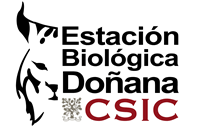About the Project
Important Information
This is a competitive position financed by the program INPhINIT from Fundación Social La Caixa for Spanish Research Centres of Excellence, Program Severo Ochoa
https://obrasociallacaixa.org/en/educacion-becas/becas-de-posgrado/inphinit/about-inphinit
•Candidates have to apply for a fellowship and if selected they can apply for a project
•POSITION: https://hosts.lacaixafellowships.org/finder
•Aplication Deadline: 2 February 2017
•Preselection results: 19 Abril 2017
•Final Announcement of results: 30 May 2017
•Start of fellowship: September- October 2017
Project Description
In this research project we will be comparing the movement ecology of two species of sympatrically breeding kestrels in the south of the Iberian Peninsula, the lesser kestrel (Falco naumanni) and the common kestrel (Falco tinnunculus). They are two morphologically similar species. The lesser kestrels shows a greater degree of specialization in prey and habitat selection while the common kestrel is a generalist species. We have selected three study areas, geographically close, with differences in habitat composition to study the movements, hunting strategies, energy expenditure, prey selection and habitat selection of breeding individuals of the two species along two annual cycles, in a comparative way. For the study we will rely on high temporal and high spatial resolution biologgers, heart-rate loggers and a remote automatic monitoring system with smart nest-boxes. The project has received funding from the Proyectos de Excelencia 2016 from the PLAN ESTATAL DE INVESTIGACIÓN CIENTÍFICA Y TÉCNICA Y DE INNOVACIÓN 2013-2016 (MINECO). The research group has a long experience in the ecology of the Lesser kestrel and has designed smart nest-boxes for automatic monitoring breeding behaviour (HORUS project). It has also experience in movement ecology and in the use of biologgers to study movement strategies of birds (lesser kestrel, bearded vulture, bald ibis, eleonora’s falcon are the species with which we are currently working).
More project details can be found in this link: https://goo.gl/mex6ny
Job position description
The candidate would conduct the research needed for a PhD dissertation initially entitled: "Differences in movement ecology and energy use between lesser and common kestrels". He would mark with biologgers two breeding pairs of lesser and common kestrels at each of three study sites (24 individuals). He would deploy 4 g biologgers from UVA-BITsthat have been successfully tested in the lesser kestrel. The idea is to follow the two members of the breeding pair for two complete years to be able to study foraging habitat selection and movement ecology considering: weather variability, differences in energy requirements, prey availability along the year, and inter-annual variability. Our main objective is to study foraging flights and selection of commuting and hunting strategies in relation to weather conditions and prey captured. Our hypothesis is that lesser kestrels being more specialized will have a narrower niche and less between-individual variability than common kestrels.
As individuals return frequently to the same foraging areas it is possible to plan direct observations in the field and film behaviour. With these data the candidate will be able to identify behaviours using the tri-axial accelerometers on the biologgers and also obtain information on hunting success in relation to hunting strategy and type of prey captured. To identify prey brought to the nest we will use video cameras of HORUS project and camera-traps at common kestrel nest boxes.
The final aim is to compare movement strategies of individuals of both species under the idea that lesser kestrels are specialist and so they are constrained in their ecological niche and there is little room for individual variation while common kestrels have a wider niche and have more individual specialization.
The candidate should have a background in animal ecology. Experience in field work, geographical information systems, database management and statistical modelling is also desired.
GROUP LEADER:
Full name: Javier María Bustamante Díaz
email: [Email Address Removed]
https://about.me/javier.bustamantediaz.7
Research project/Research Group website:
http://horus.ebd.csic.es
Key words: movement ecology, ECG, biologgers, spatial ecology, individual, specialization, ecological niche
Funding Notes
Candidates have to apply first to program INPhINIT from Fundación Social La Caixa:
https://obrasociallacaixa.org/en/educacion-becas/becas-de-posgrado/inphinit/about-inphinit
Here you have a promotional video: https://youtu.be/JBynmupA6UQ
Once selected they can choose this projec from the list of projects offered for a PhD Thesis:
https://hosts.lacaixafellowships.org/finder
References
Hernández-Pliego J, Rodríguez C, Bustamante J. Gone with the wind: Seasonal trends in foraging movement directions for a central-place forager. Current Zoology. 2014;60: 604–615.
http://digital.csic.es/handle/10261/104707
Hernández-Pliego J, Rodríguez C, Bustamante J. Why Do Kestrels Soar? PLoS ONE. 2015;10: e0145402. doi:10.1371/journal.pone.0145402
http://journals.plos.org/plosone/article?id=10.1371/journal.pone.0145402

 Continue with Facebook
Continue with Facebook

